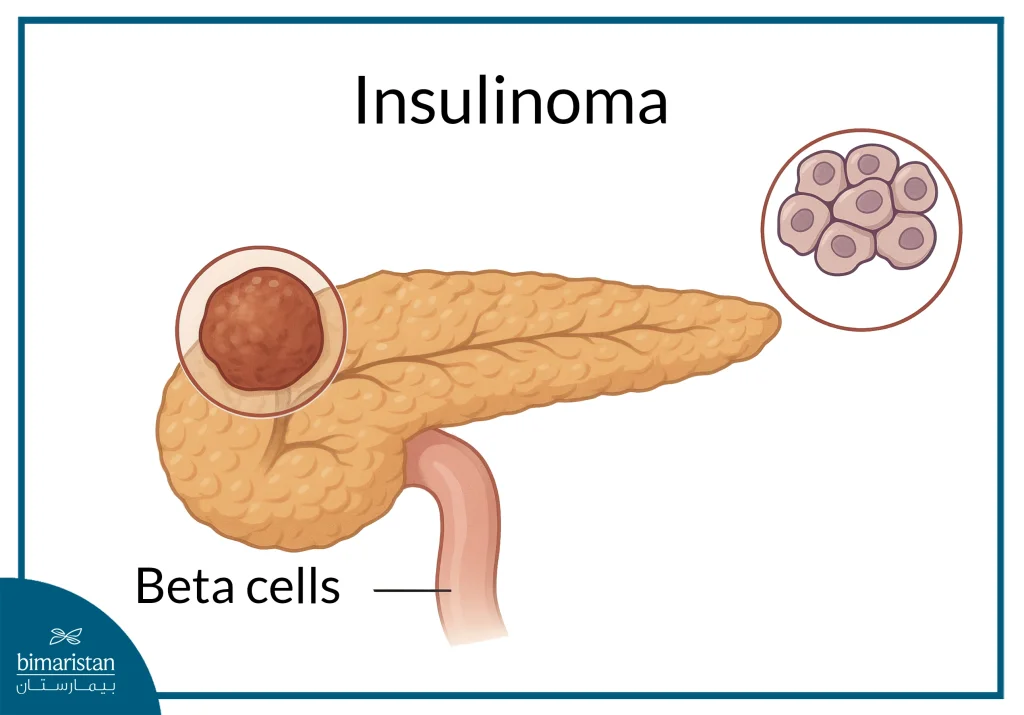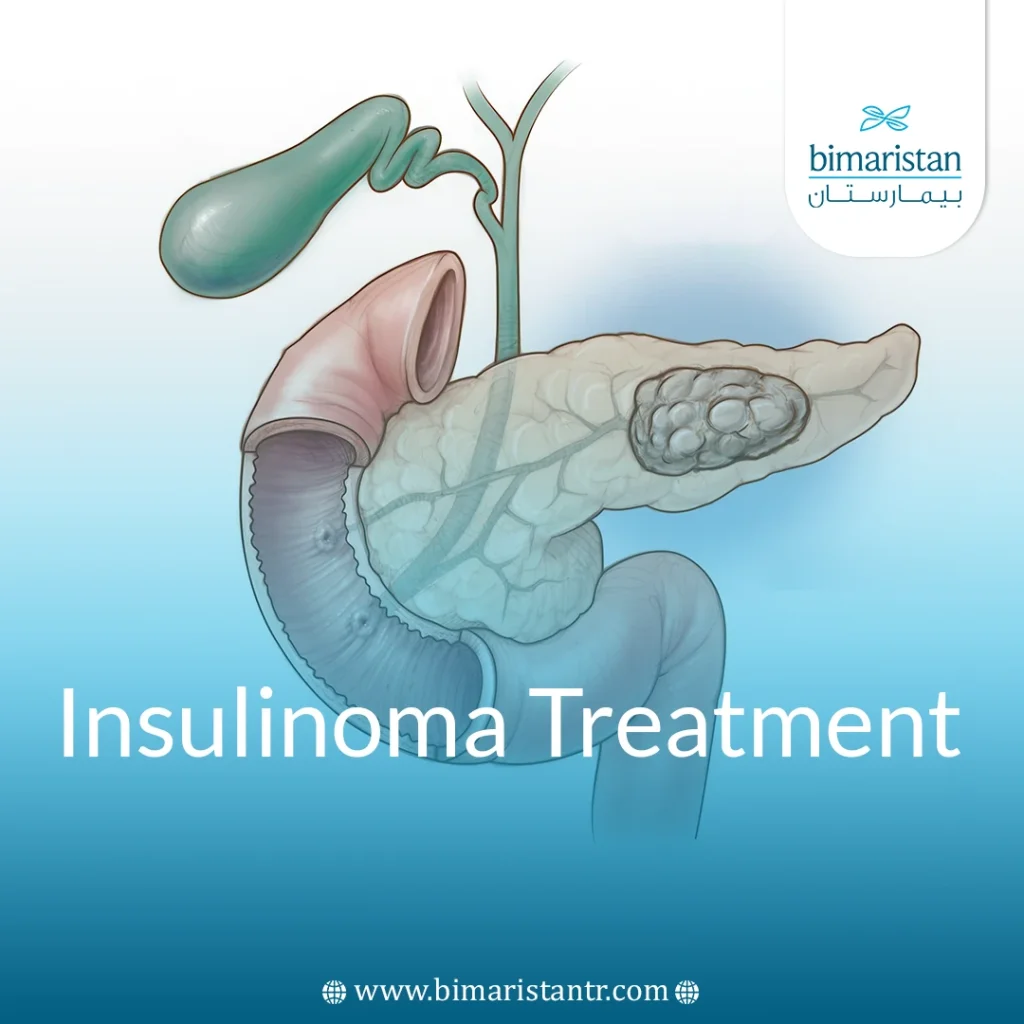Insulinoma is a rare type of pancreatic tumor arising from insulin-producing beta cells, which leads to excessive and continuous secretion of insulin in disproportion to normal sugar levels. This causes severe low blood sugar with various symptoms of hypoglycemia, so early intervention and insulinoma treatment become an essential step to avoid serious health complications.
What is an insulinoma?
Insulinoma is a rare tumor of the pancreas that originates from the beta cells that secrete insulin, and it is among the neuroendocrine tumors of the pancreas.
These tumors represent a special case because they secrete insulin independently of blood sugar concentration, which leads to a sharp drop in sugar levels and the occurrence of symptoms such as dizziness, tremors, and sweating. Although most of these tumors are benign and do not spread outside the pancreas, in a few cases, they may spread to the lymph nodes or liver.
Diagnosis depends on analyzing sugar and insulin levels, in addition to using medical imaging techniques. Surgical intervention remains the best option for insulinoma treatment and improving the quality of life in patients. Insulinoma treatment differs from other pancreatic tumors in its specific therapeutic approach.

Symptoms are more common when fasting, skipping, or delaying a meal and may include the following:
- Anxiety, behavior changes, or confusion
- Mental confusion and blurred vision
- Loss of consciousness or coma
- Convulsions or tremors
- Dizziness or headaches
- Hunger between meals; weight gain is common
- Rapid heartbeat or palpitations
- sweating
Insulinoma diagnosis
- Blood tests and prolonged fasting: Diagnosis of insulinoma is based on analyzing blood levels during a prolonged fasting test of up to 72 hours. During this period, the drop in blood sugar level is monitored with measurement of insulin, proinsulin, and C-peptide levels, which helps detect the abnormal insulin secretion that indicates the presence of the tumor.
- Magnetic resonance imaging (MRI): MRI is used to precisely locate and assess the size of a tumor within the pancreas. This test is an effective tool in detecting tumors in cases that are not clearly visible using other imaging techniques.
- Computed tomography (CT scan): A CT scan is an important option for imaging the pancreas and locating the tumor, as it helps rule out other tumors and provides detailed information about the structure and surrounding tissues of the pancreas.
- Use of PET and Octreoscan: Advanced imaging techniques such as PET and Octreoscan are used to identify tumors that express somatostatin receptors. Although Octreoscan can be more sensitive to some neuromas, it may not be the most accurate in detecting an insulinoma compared to MRI or CT.
Insulinoma treatment methods
Surgery: The first treatment option
- Removal of the tumor in the pancreas: Surgery is the primary option for Insulinoma treatment, in which the tumor is removed directly from the pancreas, either by specific removal of the tumor (enucleation) or a partial pancreatectomy if needed.
- Success rates and complications: Success rates are usually high when removing a single, non-invasive tumor, but there is a risk of complications such as bleeding or damage to neighboring tissues, which requires careful follow-up after surgery.
- The use of minimally invasive robotic surgery: Robotic techniques help reduce wound size, post-operative pain, and recovery time, without compromising the accuracy of tumor removal.
Pharmacological remedies
- Diazoxide: This medication is used to reduce the release of insulin from the tumor, helping to control hypoglycemia in patients who are not considered candidates for surgery or prior to surgery.
- Octreotide and its derivatives: These drugs help reduce insulin secretion, although their effectiveness can be variable, and are used to manage symptoms of hypoglycemia.
- Metformin in some cases: May be added to regulate blood sugar levels, with careful monitoring to adjust doses based on the body’s response.
- The importance of careful monitoring during drug therapy: Continuous monitoring ensures that dosages are adjusted, any potential complications are dealt with quickly, and blood sugar levels are monitored regularly.
Targeted therapy and chemotherapy in rare cases
- When the tumor has become malignant or the disease has spread: Targeted therapy and chemotherapy options are used in cases where the tumor exhibits unconfined or invasive behavior, necessitating more comprehensive treatment.
- Using Everolimus (Afinitor): This is a targeted drug that inhibits the growth of cancer cells and is specifically used in advanced or refractory cases.
- Experimental treatments under medical supervision: In some difficult or advanced cases, new treatments are tried under the close supervision of the medical team to evaluate effectiveness and continuously monitor for complications
Insulinoma treatment during pregnancy
- Special challenges: Mother and child face special challenges when undergoing insulinoma treatment during pregnancy. A delicate balance must be struck between insulin control and fetal safety, requiring careful monitoring and an individualized insulinoma treatment plan.
- The role of safe medications such as octreotide: Medications such as octreotide are a relatively safe option for reducing insulin secretion during pregnancy, although it is important to monitor glucose levels to make sure they are not adversely affecting the fetus.
- Timing of surgery in pregnancy if necessary: Surgery may be necessary in some cases, where the timing is carefully chosen, preferably postponing it to a safe stage of pregnancy or even after delivery, depending on the patient’s condition and stability.
Nutritional advice for insulinoma patients
- Spread carbohydrates throughout the day: It is advisable to eat carbohydrates regularly throughout the day to help stabilize sugar levels.
- Small, frequent meals: Eating small snacks and meals at frequent intervals helps avoid sudden blood sugar fluctuations.
- Avoid fasting: Long periods of fasting should be avoided as this can lead to severe low blood sugar and worsen the symptoms of the disease.
- The role of diet in improving quality of life: A balanced, non-strict diet is key to improving energy level and overall quality of life, while supporting diabetes stabilization and minimizing complications.
Does the insulinoma come back after treatment?
- Relapse rates: Although treatments are successful in many cases, there is a rare chance that an insulinoma will return after treatment.
- The importance of ongoing follow-up: Regular follow-up with the medical team is essential for early detection of any signs of tumor recurrence and treatment of any changes.
- Periodic examinations: Blood tests and medical imaging are used as essential tools to monitor the condition and prevent the development of possible relapses.
- Preventing hypoglycemia after recovery: Patients should follow a proper diet and closely monitor sugar levels even after recovery to prevent sharp drops that may affect overall health.
In conclusion, insulinoma treatment shows great diversity in the available options, including direct surgical intervention and modern pharmacological treatments. Insulinoma treatment depends on accurately assessing the condition and monitoring sugar levels to avoid complications. It is always recommended to learn about the latest techniques and use the best means in the treatment of insulinoma to ensure the effectiveness of the procedure and relieve the symptoms of the disease.
Given the sensitivity and complexity in managing the condition, it is necessary to consult a specialist doctor to determine the most appropriate plan in the treatment of insulinoma, as insulinoma treatment is an integrated option that requires careful follow-up to ensure the best results.
Sources:
- Zhuo F, Menon G, Anastasopoulou C. Insulinoma. . In: StatPearls . Treasure Island (FL): StatPearls Publishing; 2025 Jan
- MedlinePlus. (n.d.). Pancreatic tumors. Retrieved June 14, 2025

